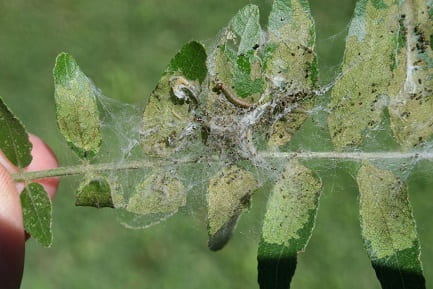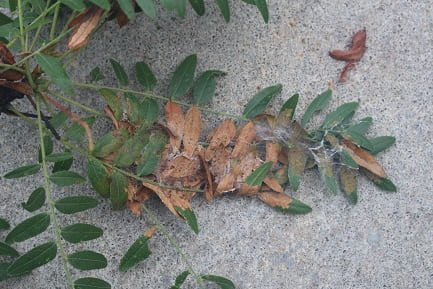–by Dr. Raymond Cloyd
Damage associated with mimosa webworm (Homadaula anisocentra) larvae/caterpillars is now quite prevalent on honeylocust (Gleditsia triacanthos) and mimosa (Albizia julibrissin) trees throughout regions of Kansas. The larvae/caterpillars are 1/2 inch long when fully-grown (Figure 1) and rapidly move backward when disturbed. Caterpillars’ web leaves together on the ends of branches (Figure 2).
Figure 1. Mimosa Webworm Caterpillars Feeding On Leaves (Raymond Cloyd, KSU)
Figure 2. Mimosa Webworm Webbing On End Of Branch (Raymond Cloyd, KSU)
Webbing, in general, starts at the tops of trees and protects caterpillars from natural enemies (parasitoids and predators) and insecticide spray applications. Heavily infested trees are brown or scorched in appearance (Figures 3 and 4) as the caterpillars skeletonize the leaf tissue. Caterpillars eventually fall from trees on a silken strand before pupating. Mimosa webworm pupates in bark crevices or pupae are attached to structures (e.g. buildings). There are two generations per year in Kansas.
Figure 3. Mimosa Webworm Caterpillar Feeding Damage (Raymond Cloyd, KSU)
Figure 4. Extensive Feeding Damage Caused By Mimosa Webworm Caterpillars (Raymond Cloyd, KSU)
Regarding management of mimosa webworm, it is too late to apply an insecticide if trees are already heavily infested with webbing because caterpillars are protected from spray applications of insecticides inside the leaf webbing. However, next year (2021), you can manage mimosa webworm caterpillar populations by applying an insecticide when the caterpillars are initially present and exposed to insecticide spray applications. Insecticides that contain the following active ingredients can be used: Bacillus thuringiensis subsp. kurstaki, spinosad, bifenthrin, cyfluthrin, and permethrin. Read the label of each product to ensure that “webworms” are listed. High-volume spray applications are required to contact the caterpillars. If possible, selective pruning can quickly remove isolated or localized infestations of mimosa webworm.


